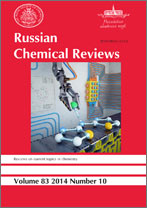|
This article is cited in 56 scientific papers (total in 56 papers)
Polymerisation of Allyl Compounds
V. I. Volodina, A. I. Tarasov, S. S. Spasskii
Institute of Solid State Chemistry of the USSR Academy of Sciences, Sverdlovsk
Abstract:
The review deals with the advances in the theory of the formation of allyl polymers and their practical applications. Until recently there was only limited interest in allyl polymers because with the usual free-radical initiation allyl compounds polymerise with difficulty and yield polymers with a low molecular weight. The principal cause of the formation of low-molecular-weight polymers is degradative chain transfer to the monomer, as a result of which the kinetic chain is terminated. A property of the degradative chain transfer is the constancy of dM/dP, i.e. a linear relation between the amount of peroxide decomposed and the amount of monomer polymerised. In addition to degradative chain transfer, a characteristic feature of allyl monomers is effective chain transfer, which depends on the structure of the monomer.
The polymerisation of diallyl compounds has a cyclolinear mechanism, which leads to the formation of macromolecules with alternating cyclic and linear units.
The behaviour of allyl monomers in copolymerisation reactions is determined by their low reactivity compared with that of the majority of vinyl monomers. The chemical structure of allyl monomers does not as a rule have a significant influence on their reactivity.
In recent years polymers based on allyl monomers have found many applications in engineering. Copolymerisation with other monomers and polymers yielded materials with high mechanical strength, thermal and chemical stability, and good insulating and adhesive properties. They are used as fibres, films, coatings, optical glasses, binders for reinforced plastics, etc.
The bibliography includes 386 references.
Citation:
V. I. Volodina, A. I. Tarasov, S. S. Spasskii, “Polymerisation of Allyl Compounds”, Usp. Khim., 39:2 (1970), 276–303; Russian Chem. Reviews, 39:2 (1970), 140–155
Linking options:
https://www.mathnet.ru/eng/rcr2335https://doi.org/10.1070/RC1970v039n02ABEH001947 https://www.mathnet.ru/eng/rcr/v39/i2/p276
|


| Statistics & downloads: |
| Abstract page: | 177 |
|





 Contact us:
Contact us: Terms of Use
Terms of Use
 Registration to the website
Registration to the website Logotypes
Logotypes









